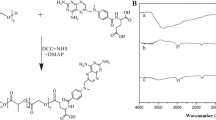Abstract
The main problems of contemporary chemotherapy are the insufficient efficacy of antitumor drugs and low selectivity of their action, development of multidrug resistance, and poor water solubility of antitumor drugs. One of the ways to improve the targeted delivery of drugs and increase their solubility is the use of polymeric nanoscale carriers. The newly synthesized thiazole derivative (N-(5-benzyl-1,3-thiazol-2-yl)-3,5-dimethyl-1-benzofuran-2-carboxamide, BF1) is cytotoxic in its activity towards some tumor cell lines. The aim of this study was to investigate the action of BF1 conjugated with novel polymeric carriers based on polyethylene glycol (PEG). The synthesized complexes exhibited a higher level of cytotoxicity towards specific tumor cell lines than the pure (unconjugated) thiazole derivative or/and doxorubicin (positive control). Complexes 4, 14 and 8, 18 were the most toxic to the human hepatocarcinoma HepG2 and the rat glioma C6 cell lines. Complex 6 exhibited a high level of toxicity towards human glioblastoma T98G and human promyelocytic leukemia HL-60 cell lines. Thus, complexes 4 and 14 based on poly(VEP-co-GMA)-graft-mPEG, complex 6 based on poly(PEGMA), and complexes 8 and 18 based on poly(PEGMA-co-DMM) selectively increase the toxic action of thiazole derivative BF1 towards tumor cells.




Similar content being viewed by others
REFERENCES
Braun, D., Cherdron, H., Rehahn, M., et al., Polymer Synthesis: Theory and Practice. Fundamentals, Methods, Experiments, Berlin: Springer, 2013.
Chen, D., Pan, X., Xie, F., et al., Codelivery of doxorubicin and elacridar to target both liver cancer cells and stem cells by polylactide-co-glycolide/d-alpha-tocopherol polyethylene glycol 1000 succinate nanoparticles, Int. J. Nanomed., 2018.https://doi.org/10.2147/IJN.S181928
Crompton, T.R., Practical Polymer Analysis, Boston: Springer, 1993.
Dos Santos, T.A., Silva, A.C., Silva, E.B., et al., Antitumor and immunomodulatory activities of thiosemicarbazones and 1,3-thiazoles in Jurkat and HT-29 cells, Biomed. Pharmacother., 2016. https://doi.org/10.1016/j.biopha.2016.05.038
Feng, R., Zhu, W., Teng, F., et al., Poly(ethylene glycol) amphiphilic copolymer for anticancer drugs delivery, Anticancer Agents Med. Chem., 2015. https://doi.org/10.2174/1871520614666141124102347
Finiuk, N.S., Hreniuh, V.P., Ostapiuk, Yu.V., et al., Antineoplastic activity of novel thiazole derivatives, Biopolym. Cell, 2017. https://doi.org/10.7124/bc.00094B
Francuskiewicz, F., Polymer Fractionation, Berlin: Springer, 1994.
Han, J., Zhao, D., Li, D., et al., Polymer-based nanomaterials and applications for vaccines and drugs, Polymers, 2018. https://doi.org/10.3390/polym10010031
Heffeter, P., Riabtseva, A., Senkiv, Y., et al., Nano-formulation improves activity of the (pre)clinical anticancer ruthenium complex KP1019, J. Biomed. Nanotechnol., 2014. https://doi.org/10.1166/jbn.2014.1763
Jain, S., Pattnaik, S., Pathak, K., et al., Anticancer potential of thiazole derivatives: a retrospective review, Mini Rev. Med. Chem., 2018. https://doi.org/10.2174/1389557517666171123211321
Khan, N., Afaq, F., and Mukhtar, H., Cancer chemoprevention through dietary antioxidants: progress and promise, Antioxid. Redox Signal., 2008. https://doi.org/10.1089/ars.2007.1740
Kobylinska, L., Patereha, I., Finiuk, N., et al., Comb-like PEG-containing polymeric composition as low toxic drug nanocarriers, Cancer Nanotechnol., 2018. https://doi.org/10.1186/s12645-018-0045-5
Li, M.H., Yang, P., Yang, T., et al., A novel water-soluble benzothiazole derivative BD926 triggers ROS-mediated B lymphoma cell apoptosis via mitochondrial and endoplasmic reticulum signaling pathways, Int. J. Oncol., 2016. https://doi.org/10.3892/ijo.2016.3684
Mitina, N.Y., Riabtseva, A.O., Garamus, V.M., et al., Morphology of the micelles formed by a comb-like PEG-containing copolymer loaded with antitumor substances with different water solubilities, Ukr. J. Phys., 2020. https://doi.org/10.15407/ujpe65.8.670
Mohammad, A. and Dexi, L., Organ-based drug delivery, J. Drug. Target, 2018. https://doi.org/10.1080/1061186X.2018.1437919
Mohareb, R.M., Abdallah, A.M., and Ahmed, E.A., Synthesis and cytotoxicity evaluation of thiazole derivatives obtained from 2-amino-4,5,6,7-tetrahydro-benzo[b]thiophene-3-carbonitrile, Acta Pharm., 2017. https://doi.org/10.1515/acph-2017-0040
Nath Roy, D., Goswami, R., and Pal, A., Nanomaterial and toxicity: what can proteomics tell us about the nanotoxicology?, Xenobiotica, 2017. https://doi.org/10.1080/00-498254.2016.1205762
Paiuk, O.L., Mitina, N.Ye., Riabtseva, A.O., et al., Structure and colloidal-chemical characteristics of polymeric surface active substances based on polyethylene-glycolcontaining macromeres, Vopr. Khim. Khim. Tekhnol., 2018. https://doi.org/10.32434/0321-4095-2018-121-6-63-71
Riabtseva, A., Mitina, N., Boiko, N., et al., Structural and colloidal-chemical characteristics of nanosized drug delivery systems based on pegylated comb-like carriers, Chem. Chem. Technol., 2012. https://doi.org/10.23939/chcht06.03.291
Roy, P.S. and Saikia, B.J., Cancer and cure: a critical analysis, Indian. J. Cancer, 2016. https://doi.org/10.4103/0019-509X.200658
Saleh, T. and Shojaosadati, S.A., Multifunctional nano-particles for cancer immunotherapy, Hum. Vaccin. Immun., 2016. https://doi.org/10.1080/21645515.2016.1147635
Steyermark, A., Quantitative Organic Microanalysis, New York: Academic, 1961.
Turov, K.V., Barvinchenko, V.M., Krupska, T.V., et al., Antiradical properties of thiazole derivatives. The effect on the metabolic activity of yeast, Biotechnology, 2012, vol. 5, no. 3, pp. 75–83.
Voronov, S.A., Kiselyov, E.M., Minko, S.S., et al., Structure and reactivity of peroxide monomers, J. Polym. Sci. Pol. Chem., 1996. https://doi.org/10.1002/(SICI)1099-0518(19960915)34:12<2507::AID POLA24>3.0.CO;2-B
Wang, L., Du, J., Zhou, Y., et al., Safety of nanosuspensions in drug delivery, Nanomedicine, 2017. https://doi.org/10.1016/j.nano.2016.08.007
Zdvizhkov, Y. and Bura, M., Particular qualities of application of polyethylene glycol-based polymeric carrier for drug delivery to the goal target, Visn. Lviv Univ., Ser. Biol., 2014, vol. 64, pp. 3–20.
Zhang, J., Li, S., and Li, X., Polymeric nano-assemblies as emerging delivery carriers for therapeutic applications: a review of recent patents, Rec. Pat. Nanotechnol., 2009. https://doi.org/10.2174/187221009789177803
Zhao, K., Li, D., Shi, C., Biodegradable polymeric nanoparticles as the delivery carrier for drug, Curr. Drug. Deliv., 2016. https://doi.org/10.2174/156720181304160521004609
Funding
The study was supported under the state budgeted program no. 0119U002201, Ministry of Education and Science of Ukraine.
Author information
Authors and Affiliations
Corresponding authors
Ethics declarations
The authors declare that they have no conflict of interests.
This paper does not contain any investigations with the participation of people and animals as the objects of studies.
Additional information
Translated by N. Tarasyuk
About this article
Cite this article
Finiuk, N.S., Popovych, M.V., Shalai, Y.R. et al. Antineoplastic Activity In Vitro of 2-amino-5-benzylthiasol Derivative in the Complex with Nanoscale Polymeric Carriers. Cytol. Genet. 55, 19–27 (2021). https://doi.org/10.3103/S0095452721010084
Received:
Revised:
Accepted:
Published:
Issue Date:
DOI: https://doi.org/10.3103/S0095452721010084




